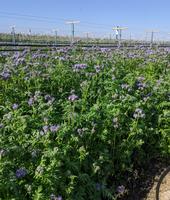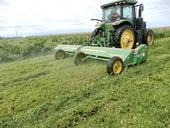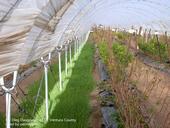- Author: Pamela S Kan-Rice

Additional guidance needed for groundwater management strategies
Cover crops are planted to protect and improve the soil between annual crops such as tomatoes or between rows of tree and vine crops, but growers may be concerned about the water use of these plants that don't generate income.
“Cover crops are one of the most popular practices we see farmers employ through our Healthy Soils Program,” said Karen Ross, secretary of the California Department of Food and Agriculture. “Cover crops supply a host of benefits, such as helping to protect against soil erosion, improving soil...
- Author: Pamela Kan-Rice

Farmers and ranchers are invited on a tour to learn how to use cover crops to build soil health. A full-day tour of several cover crop sites in orchards and annual crop fields in the Sacramento Valley is being offered on March 3 by the Western Cover Crop Council's Southwest Region Committee.
“The goal of this tour is to demonstrate ways to use cover crops effectively in annual crops and orchards in the Sacramento Valley,” said tour organizer Sarah Light, UC Cooperative Extension agronomy advisor.
“This tour will cover a range of topics, including cover crop selection,...
- Author: Kevin Fontana Fantinatti
- Author: Sonja Brodt
- Author: Vivian Wauters

In late February, in an almond orchard in the Sacramento Valley, the fall-planted cover crop mix of grasses, brassicas and legumes had barely produced a green fuzz above the soil surface, and it was unclear when it would bloom. Unfortunately, this scene is becoming more frequent across California, as climate change causes more prolonged droughts and rain-dependent winter cover crops can barely grow, which delays or reduces bloom, essential for supporting pollinators. Fortunately, California native plant species have evolved with drought and have developed many strategies to survive and reproduce in those conditions.
Would it be possible to...
- Author: Jeannette E. Warnert

A group of California organic farmers is sharing information about their efforts to combine reduced tillage with the use of cover crops, which they have been planting on their vegetable farms for decades to protect soil while adding carbon and diversity to their production systems.
“Every one of the pioneering farmers has seen tremendous benefits from the practices,” said Jeff Mitchell, UC Cooperative Extension vegetable crops specialist. “These are the very growing practices that we have demonstrated over two decades of research to benefit soil health, environmental conservation and the bottom line on plots near Five Points in Fresno County.”
The...
- Author: Romy Basler, IPM Pest Management Guidelines Coordinator
- Author: Oleg Daugovish

Growing caneberries under tunnels keep the berries dry even when it rains, preventing disease and assuring fruit quality. However, during rains, water drains from the plastic down into rows that contain the anchoring posts of the tunnel structure. The accelerated runoff in these post rows causes soil erosion and sediment and nutrient loss. Persistent soil moisture in post rows also promotes weed growth. While weeds growing in the anchoring rows do not directly compete with canes, they can reproduce and quickly spread into neighboring cane rows.
Rather than using herbicides in caneberry growing tunnels, the UC Integrated Pest Management program suggests planting a cover crop to prevent weeds in anchor rows.
Cover crops in...



